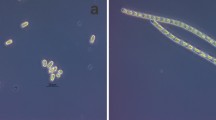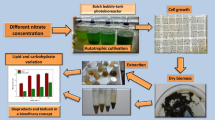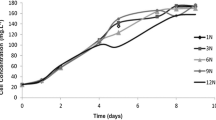Abstract
Microalgae are unicellular and photosynthetic organisms which have great potential for providing various products of interest in the food, chemicals, pharmaceuticals, and cosmetics industry. The green alga Ankistrodesmus braunii has been cited as capable of producing large amounts of lipids. In this sense, this work aims to study A. braunii growth in tubular photobioreactor using different amounts of nitrogen and under different cultivation processes. In batch cultures, the maximum biomass concentration (Xm) was 1588 ± 11 mg L−1 using 20 mM of NaNO3. A fed-batch process with the addition of 20 mM NaNO3 each 48 h from the first to the sixth cultivation day reached Xm = 2753 ± 7 mg L−1. The semi-continuous process was effective to eliminate the lag phase, allowing to obtain Xm = 2399 ± 5 mg L−1. In this condition, the protein and lipid levels in the biomass were 33.1 ± 0.2% and 38.6 ± 0.2%, respectively. The maximum specific growth rate (μm) reached a maximum value of 0.998 day−1 in the semi-continuous process using 20 mM NaNO3. The results of this study show the potential for the production in a large scale of A. braunii as a source of protein and lipids for commercial applications.






Similar content being viewed by others
References
AOAC (2007) Official methods of analysis of AOAC international, 18th edn. Association of Official Analytical Chemists, Washington
Becker EW (1988) Micro-algae for human and animal consumption. In: Borowitzka MA, Borowitzka LJ (eds) Micro-algal biotechnology. Cambridge University Press, Cambridge, pp 222–256
Becker EW (1994) Microalgae: biotechnology and microbiology. Cambridge University Press, Cambridge
Becker W (2004) Microalgae in human and animal nutrition. In: Richmond A (ed) Handbook of microalgal culture. Biotechnology and Applied Phycology. Blackwell Science, Oxford, pp 312–351
Bezerra RP, Montoya EYO, Sato S, Carvalho JCM, Converti A (2011) Effects of light intensity and dilution rate on the semi continuous cultivation of Arthrospira (Spirulina) platensis. A kinetic Monod-type approach. Bioresour Technol 102:3215–3219
Blair MF, Kokabian B, Gude VG (2014) Light and growth medium effect on Chlorella vulgaris biomass production. J Environ Chem Eng 2:665–674
Borowitzka MA (2013) High-value products from microalgae – their development and commercialization. J Appl Phycol 25:743–756
Brown MR (1991) The amino-acid and sugar composition of 16 species of microalgae used in mariculture. J Exp Mar Biol Ecol 145:79–99
Brown LM, Zeiler KG (1993) Aquatic biomass and carbon dioxide trapping. Energy Convers Manag 34:1005–1013
Campos VB, Barbarino E, Lourenço SO (2010) Growth and chemical composition of ten species of marine microalgae. Ciênc Rural 40:339–347
Carvalho JCM, Francisco FR, Almeida KA, Sato S, Converti A (2004) Cultivation of Spirulina platensis by fed batch process at exponentially-increasing feeding rate of ammonium chloride. J Phycol 40:589–597
Carvalho JCM, Sato S, Converti A, Bezerra RP, Matsudo MC, Vieira DCM, Ferreira LS, Rodrigues MS (2009). Método de aproveitamento de dióxido de carbono e seu uso no cultivo de microrganismos fotossintetizantes. Brazil Patent Application No. 0805123-2, p 82
Chisti Y (2004) Microalgae: our marine forests. Biotechnol Adv 22:565–567
Colla LM, Reinehr CO, Reichert C, Costa JAV (2007) Production of biomass and nutraceutical compounds by Spirulina platensis under different temperature and nitrogen regimes. Bioresour Technol 98:1489–1493
Cruz-Martinez LC, Jesus CKC, Matsudo MC, Danesi EDG, Sato S, Carvalho JCM (2015) Growth and composition of Arthrospira (Spirulina) platensis in a tubular photobioreactor using ammonium nitrate as the nitrogen source in a fed-batch process. Braz J Chem Eng 32:347–356
D’Alessandro EB, Filho NRA (2016) Concepts and studies on lipid and pigments of microalgae: a review. Renew Sust Energy Rev 58:832–841
Formighieri C (2015) Solar-to-fuel conversion in algae and cyanobacteria. Springer, Berlin
George B, Pancha I, Desai C, Chokshi K, Paliwal C, Ghosh T, Mishra S (2014) Effects of different media composition, light intensity and photoperiod on morphology and physiology of freshwater microalgae Ankistrodesmus falcatus – a potential strain for bio-fuel production. Bioresour Technol 171:367–374
Guillard RR, Rhyter JH (1962) Studies of marine planktonic diatoms: I. Cyclotella nana Hustedt and Detonula confervacea (Cleve) Gran. Can J Microbiol 8:229–239
Guiry MD (2012) How many species of algae are there? J Phycol 48:1057–1063
Hipkin CR, Syrett PJ (1977) Nitrate reduction by whole cells of Ankistrodesmus braunii and Chlamydomonas reinhardi. New Phytol 79:639–648
Jayanta T, Chandra KM, Chandra GB (2012) Growth, total lipid content and fatty acid profile of a native strain of the freshwater oleaginous microalgae Ankistrodesmus falcatus (Ralf) grown under salt stress condition. Int J Biol Sci 8:27–35
Leduy A, Zajic JE (1973) A geometric approach for differentiation of an experimental function at a point applied to growth and product formation. Biotechnol Bioeng 25:805–810
López CVG, García MCC, Fernández FGA, Bustos CS, Chisti Y, Sevilla JMF (2010) Protein measurements of microalgal and cyanobacterial biomass. Bioresour Technol 101:7587–7591
Moheimani NR (2016) Tetraselmis suecica culture for CO2 bioremediation of untreated flue gas from a coal-fired power station. J Appl Phycol 28:2139–2146
Norton TA, Melkonian N, Andersen R (1996) Algal biodiversity. Phycologia 35:308–326
Olguín EJ, Galicia S, Angulo-Guerrero O, Hernández E (2001) The effect of low light flux and nitrogen deficiency on the chemical composition of Spirulina sp. (Arthrospira) grown on digested pig waste. Bioresour Technol 77:19–24
Sassano CEN, Gioielli LA, Ferreira LS, Rodrigues MS, Sato S, Converti A, Carvalho JCM (2010) Evaluation of the composition of continuously-cultivated Arthrospira (Spirulina) platensis biomass using ammonium chloride as nitrogen source. Biomass Bioenergy 34:1732–1738
Sayre R (2010) Microalgae: the potential for carbon capture. Bioscience 60:722–727
Schlösser UG (1982) Sammlung von Algenkulturen. Ber Deut Bot Ges 95:181–276
Sipaúba-Tavares LH, Pereira AML (2008) Large scale laboratory cultures of Ankistrodesmus gracilis (Reisch) Korsikov (Chlorophyta) and Diaphanosoma biergei Korinek, 1981 (Cladocera). Braz J Biol 68:875–883
UTEX (2016) The culture collection of algae at the University of Texas at Austin. http://www.sbs.utexas.edu/utex/. Accessed 13 April 2016
Williams VR, McMillan R (1961) Lipids of Ankistrodesmus braunii. Science 133:459–460
Acknowledgments
The authors acknowledge the support of “Conselho Nacional de Desenvolvimento Científico e Tecnológico” (CNPq), São Paulo, Brazil.
Author information
Authors and Affiliations
Corresponding author
Ethics declarations
Conflict of interest
The authors declare that they have no conflict of interest.
Additional information
Publisher’s note
Springer Nature remains neutral with regard to jurisdictional claims in published maps and institutional affiliations.
Rights and permissions
About this article
Cite this article
Bresaola, M.D., Morocho-Jácome, A.L., Matsudo, M.C. et al. Semi-continuous process as a promising technique in Ankistrodesmus braunii cultivation in photobioreactor. J Appl Phycol 31, 2197–2205 (2019). https://doi.org/10.1007/s10811-019-01774-0
Received:
Revised:
Accepted:
Published:
Issue Date:
DOI: https://doi.org/10.1007/s10811-019-01774-0




